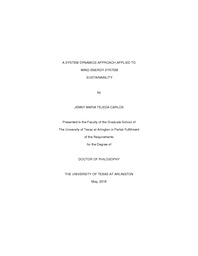
ATTENTION: The works hosted here are being migrated to a new repository that will consolidate resources, improve discoverability, and better show UTA's research impact on the global community. We will update authors as the migration progresses. Please see MavMatrix for more information.
Show simple item record
| dc.contributor.advisor | Ferreira, Susan | |
| dc.creator | Tejeda Carlos, Jenny Maria | |
| dc.date.accessioned | 2016-07-08T20:10:44Z | |
| dc.date.available | 2016-07-08T20:10:44Z | |
| dc.date.created | 2016-05 | |
| dc.date.issued | 2016-05-18 | |
| dc.date.submitted | May 2016 | |
| dc.identifier.uri | http://hdl.handle.net/10106/25772 | |
| dc.description.abstract | Sustainability of energy systems is one of the most important challenges currently facing humanity. Access to energy is critical to ensure economic and social development of a nation (UNDP et al., 2000); however, extraction, production and consumption of energy resources are also associated with high volumes of greenhouse gas (GHG) emissions, environmental damage and, in some cases, adverse health effects in communities where energy facilities are located. Renewable energy sources have been considered as an alternative to traditional energy sources to meet energy demand in a sustainable manner (Del Rio and Burguillo, 2008). Wind energy is considered to be one of the cleanest sources of energy. Furthermore, wind energy is one of the fastest growing energy sources worldwide. Wind energy systems are large complex systems that involve heterogeneous stakeholders as well as various system elements.
It is critical to better understand the sustainability of wind energy systems from a holistic perspective over the lifecycle of the system to ensure its favorable contribution to the sustainability of the energy system as a whole. Wind energy system sustainability focuses on a balance between economic, social and environmental objectives.
Systems thinking studies a system of interest as a whole, where all the system’s parts interact with each other as well as with other systems. System dynamics, a systems thinking methodology, has been used to evaluate the sustainability of wind energy systems.
A wind energy system sustainability causal model has been developed to represent key factors and factor relationships related to wind energy system sustainability during the installation, operation and maintenance, and decommissioning phases. A system dynamics simulator was developed to represent causal model factors and model the behavior of these factors. The aim of the simulator is to help decision makers to understand the impacts of their decisions. A better understanding of factors and factor relationships associated with wind energy system sustainability would provide energy decision makers a way to assess sustainability of a wind energy system. | |
| dc.format.mimetype | application/pdf | |
| dc.language.iso | en_US | |
| dc.subject | Wind energy system | |
| dc.subject | Sustainability | |
| dc.subject | System dynamics | |
| dc.subject | Systems thinking | |
| dc.title | A SYSTEM DYNAMICS APPROACH APPLIED TO WIND ENERGY SYSTEM SUSTAINABILITY | |
| dc.type | Thesis | |
| dc.degree.department | Industrial and Manufacturing Systems Engineering | |
| dc.degree.name | Doctor of Philosophy in Industrial Engineering | |
| dc.date.updated | 2016-07-08T20:11:15Z | |
| thesis.degree.department | Industrial and Manufacturing Systems Engineering | |
| thesis.degree.grantor | The University of Texas at Arlington | |
| thesis.degree.level | Doctoral | |
| thesis.degree.name | Doctor of Philosophy in Industrial Engineering | |
| dc.type.material | text | |
Files in this item
- Name:
- TEJEDACARLOS-DISSERTATION-2016.pdf
- Size:
- 7.846Mb
- Format:
- PDF
This item appears in the following Collection(s)
Show simple item record


